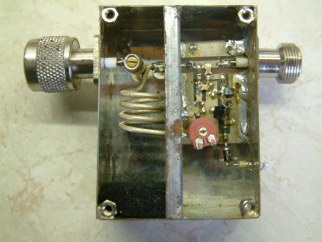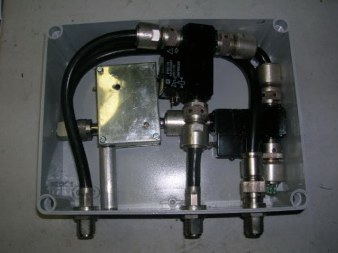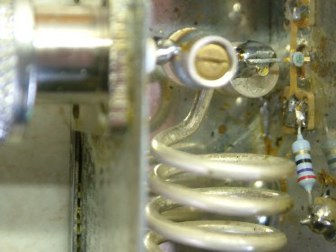DJ9BV 2mtr. Preamp
This PreAmp is currently no longer in service. It has been replaced by the High IP, low noise PreAmp
designed by PA3BIY. For documentation, the old DJ9BV PreAmp is shown here.
The DJ9BV design uses an MGF1302 FET as active component. The input circuit consists of a large silver-plated coil and two high-Q variable capacitors.
 The PreAmp is build in a tin-plated housing. In the middle is a seperation wall, into which the active component is build. Besides a hole in this seperation wall are two 1nF capacitors to were the two source-leads are connected.
During one of the HAM-fests organised in the Netherlands the noise-figure and Gain of this box was measured. The NF-factor could be optimised to 0.4dB in favour to some Gain. However due to the thin wall of the housing, the NF-factor varies quite a lot when bending the box a little. This is also the reason to start working on another design (PA3BIY) that is to be build into a stable aluminum box.
Below are some additional detailed pictures of this PreAmp, also pictures were it is completed in a box, including two heavy-duty coaxial relay's. As the GS35b and the coupling capacitor in the cavity-box, these relay's of russian making and delivered by dr. Alex Gavva, see his site here: www.nd2x.net/ur4ll.html
  In the above picture, the MGF1302 can be recognised were it is soldered with the two source-leads to the 1nF trapezium capacitors. The two variable high-Q capacitors gives the PreAmp possibillities to optimize for NF-factor and Gain.
The picture to the right shows the completed box ready for mounting to the antenna-system, were a seperated TX/RX line is used. This box holds the PreAmp and the two REW-14 coaxial relays. There are two of these relay's used because the isolation of a signle relay is insufficient to protect the PreAmp against too high RF-level during TX. Two of these relay's in series connection, together with a 50Ohm load at the other port of the second relay, the isolation turned out to be over 90dB. This is judged to be adequate for the expected RF-power from the GS35b tube that is used on VHF.
|